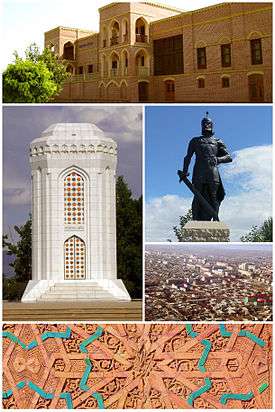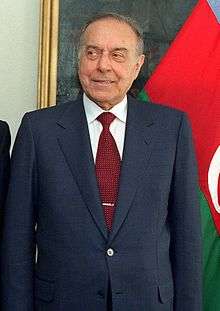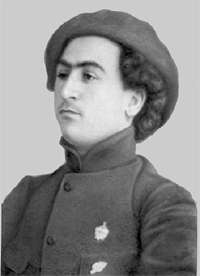Nakhchivan (city)
Coordinates: 39°12′32″N 45°24′44″E / 39.20889°N 45.41222°E
| Nakhchivan Naxçıvan Нахчыван | ||
|---|---|---|
| City and municipality | ||

 | ||
| ||
 Nakhchivan | ||
| Coordinates: 39°12′58″N 45°24′38″E / 39.21611°N 45.41056°E | ||
| Country |
| |
| Autonomous republic | Nakhchivan | |
| Area | ||
| • Total | 15 km2 (6 sq mi) | |
| • Land | 14.2 km2 (5.5 sq mi) | |
| • Water | 0.8 km2 (0.3 sq mi) | |
| Elevation | 873 m (2,864 ft) | |
| Population (2010)census data[1] | ||
| • Total | 74,500 | |
| Demonym(s) | Naxçıvanli | |
| Time zone | GMT+4 (UTC+4) | |
The city of Nakhchivan (Azerbaijani: Naxçıvan, Нахчыван, ناخجیوان) is the capital of the eponymous Nakhchivan Autonomous Republic of Azerbaijan, located 450 km (280 mi) west of Baku. The municipality of Nakhchivan consists of the city of Nakhchivan, the settlement of Əliabad and the villages of Başbaşı, Bulqan, Haciniyyət, Qaraçuq, Qaraxanbəyli, Tumbul, Qarağalıq, and Daşduz.[2] It is spread over the foothills of Zangezur Mountains, on the right bank of the Nakhchivan River at an altitude of 873 m (2,864 ft) above sea level.
Since June 9, 2009, by the decree of the President of the Azerbaijan Republic, the Bulqan, Garachug, Garakhanbeyli, Tumbul and Haciniyyət villages of the Babek Rayon are included in the scope of the administrative territorial unit of the Nakhchivan city.[3]
History
Legends and traditions
Armenian tradition claims Noah as the founder of Nakhichevan (the Naxuana of Ptolemy), and a mound of earth in the city is still visited by many pilgrims as his grave.[4] See Tomb of Noah and Noah’s Mausoleum (Nakhchivan, Azerbaijan). It should be noted that Armenian literature of the 5th through the 10th centuries does not have an Ark story. It is not until the 13th century that the Ark legends began to appear in Armenia, and by the 14th century these stories became popular.[5]
Antiquity
Nakhchivan was one of the prominent cities of the Armenian Kingdom under the Artaxides, Arshakides and Bagratides dynasties from the 2nd century BC until the 11th century AD.[6][7][8] In the 2nd century, Nakhchivan was known to Ptolemy under the name Ναξουὰνα (Naxouana), and some scholars have sought to identify Strabo's otherwise unidentified Arxata, mentioned in his description of the cities of Armenia, with Nakhchivan. Herodotus wrote that the river of Araz flows from the mountains of Matean to the country of Nakhar.[9] Potts[10] writes that Nakhchivan was probably the capital of the Siwnik region of Sassanid Armenia during the late-Sassanid period, when Siwnik was described as being located "along the Araxes" by Ananias of Shirak. According to Sebeos, the Byzantine emperor Heraclius marched through the Nakhchivan region during his campaign against the Sassanid empire in 627-628. Some Armenian chroniclers additionally state that Heraclius destroyed the town of Nakhchivan before marching on to Ganzak. A legend that the city of Nakhchivan was founded by Noah developed during the Christian-era.[11]
Feudal era
At the beginning of the 12th century Nakhchivan became the capital of Atabek's state. At the start of the 20th century Nakhchivan was the capital of a district of Erivan Governorate of the Russian Empire.[12]
Modern era

Republic era
During Nagorno-Karabakh War, the city like the region itself fell under a blockade. Although the city has no direct land connection to Azerbaijan, it has increased connections with Turkey and Iran in the recent years.[13] During 1995 to 2012, Nakhchivan has undergone massive redevelopment with the region's GDP rising by a multiple of 48.[14]
Geography
The city is spread over the foothills of Zangezur chain, on the right bank of the Nakhchivan River at an altitude of almost 1,000 m (3,300 ft).
The floods and soil erosion spiked because of the decreased forest cover along riverbanks.[13] As a result, reforestation projects implemented in the city to encourage tree planting.[13]
Climate
Nakhchivan has a continental semi-arid climate (Köppen BSk) with short but cold, snowy winters and long, dry, very hot summers.
| Climate data for Nakhchivan | |||||||||||||
|---|---|---|---|---|---|---|---|---|---|---|---|---|---|
| Month | Jan | Feb | Mar | Apr | May | Jun | Jul | Aug | Sep | Oct | Nov | Dec | Year |
| Average high °C (°F) | 0.8 (33.4) |
4.0 (39.2) |
12.3 (54.1) |
20.1 (68.2) |
24.7 (76.5) |
29.5 (85.1) |
34.7 (94.5) |
33.7 (92.7) |
30.1 (86.2) |
21.9 (71.4) |
12.6 (54.7) |
5.1 (41.2) |
19.1 (66.4) |
| Daily mean °C (°F) | −4.0 (24.8) |
−0.5 (31.1) |
5.4 (41.7) |
12.4 (54.3) |
17.5 (63.5) |
22.4 (72.3) |
26.9 (80.4) |
26.2 (79.2) |
21.9 (71.4) |
14.1 (57.4) |
6.5 (43.7) |
0.9 (33.6) |
12.5 (54.5) |
| Average low °C (°F) | −6.8 (19.8) |
−4.3 (24.3) |
1.0 (33.8) |
7.4 (45.3) |
11.5 (52.7) |
15.9 (60.6) |
20.0 (68) |
18.7 (65.7) |
14.7 (58.5) |
8.2 (46.8) |
2.3 (36.1) |
−2.5 (27.5) |
7.2 (45) |
| Average precipitation mm (inches) | 19 (0.75) |
18 (0.71) |
29 (1.14) |
38 (1.5) |
36 (1.42) |
30 (1.18) |
17 (0.67) |
8 (0.31) |
11 (0.43) |
26 (1.02) |
20 (0.79) |
15 (0.59) |
267 (10.51) |
| Average precipitation days | 5 | 4 | 6 | 7 | 9 | 5 | 2 | 2 | 2 | 5 | 4 | 4 | 55 |
| Mean monthly sunshine hours | 82.9 | 117.3 | 188.3 | 202.6 | 254.5 | 324.0 | 364.4 | 338.7 | 302.5 | 215.6 | 148.1 | 121.1 | 2,660 |
| Source: NOAA[15] | |||||||||||||
Economy
Traditionally, Nakhchivan was home to trade industry, handicraft, shoemaking and hatmaking. These industries have been largely replaced. The restoration enterprises and development industry, liberalization of foreign trade and the extension of the customs infrastructure, which has been largely responsible for Nakchivan's growth in the last two decades, are now major parts of Nakchivan's economy.[16]
Culture
The city has a wide range of cultural activities, amenities and museums. Heydar Aliyev Palace, which has a permanent local painting exhibition and a theatre hall for an audience of 1000 people, and a recently restored Soviet-time Opera Theatre where the Nakhchivan State Musical Drama Theatre realises theatre plays, concerts, musicals and opera.[17]
Many of the city's cultural sites is expected to be celebrated in 2018 when Nakhchivan was designated an Islamic Culture Capital.[18]
Architecture

The city is home Momine Khatun Mausoleum, Gulustan Mausoleum, Noah's Mausoleum, Garabaghlar Mausoleum, Yusif ibn Kuseyir Mausoleum, Imamzadeh mausoleum and Mausoleum of Huseyn Javid mausoleums.[19]
The main sight in the city is the heavily restored 12th-century Momine Khatun Mausoleum, also known as Atabek Gumbezi. Momine Khatun was the wife of Eldegizid Atabek Jahan Pahlivan, ruler of the Atabek Eldegiz emirate. The 10-sided monument is decorated with intricate geometrical motives and Kufic script, it uses turquoise glazed bricks. It shares the neighbourhood with a statue of its architect - Ajami Nakhchivani - and a bust of Heydar Aliyev. Also from the 12th century and by the same architect, is the octagonal Yusuf Ibn Kuseir tomb, known as Atababa, half abandoned near the main cemetery.
In 1993, the white marble mausoleum of Hussein Javid was built. The Azerbaijani writer died in the Gulag during Joseph Stalin's Great Purge. Both the mausoleum and his house museum are located east of the theatre. Although being a recent construction, Huseyn Javid's mausoleum is of great iconic importance, representing the ability of the exclave to live despite the Armenian embargo and becoming a symbol of Nakhchivan itself.
The mausoleums of Nakhichevan was entered for possible inclusion in the List of World Heritage Sites, UNESCO in 1998 by Gulnara Mehmandarova — president of Azerbaijan Committee of ICOMOS—International Council on Monuments and Sites.[20]
Cuisine
Nakchivan’s signature cuisine includes shirin plov (sweet rice with gravy; made with mutton, hazelnuts, almonds and dried fruits), dastana, komba, tendir lavash and galin.[21]
Museums and galleries
The city also has many historical museums, the literature museum of Nakhchivan Autonomous Republic, Nakhchivan State History Museum, The Nakhchivan State Carpet Museum, and the house museums of Jamshid Nakhchivanski and Bahruz Kangarli.[22] There is also an archaeological museum found on Istiqlal street. The city has a few interesting mosques, particularly the Juma mosque, with its large dome.
Modern museums in Nakchivan include the Museum under Open Air, Heydar Aliyev Museum and the Memorial Museum (Xatıra Muzeyi), dedicated to the national strife between Armenia and Azerbaijan.[23]
Music and media
The regional channels Naxçıvan TV and Kanal 35, and newspaper Sharg Gapisi are headquartered in the city.[24]
Sports
Araz Naxçivan one of the top futsal clubs in the European futsal arena and regularly participates in UEFA Futsal Cup.[25][26][27]
Nakhchivan had one professional football team, Araz-Naxçıvan, which competed in the top-flight of Azerbaijani football, the Azerbaijan Premier League.[28]
In 2014, the city hosted Masters Weightlifting World Cup.[29]
Education
There are 3 professional, 6 musical, 22 secondary schools and a military cadet school in Nakchivan administered by the city council.[30]
Universities and colleges
Nakchivan is one of the Azerbaijan's main centre of education and home to numerous universities:
- Nakhchivan State University
- Nakhchivan Private University
- Nakhchivan Teachers Institute
Transport
Public transport
Nakhchivan has a large urban transport system, mostly managed by the Ministry of Transportation.In 2013, Ministry of Transportation stated that city, along with Ganja and Sumqayit will have new subway line within the framework of the 20-year subway program.[31][32]
Nakhchivan's trolleybus system at its height, it consisted of three lines and existed until 2004.[33]
Air
Nakhchivan Airport is the only commercial airport serving Nakhchivan. The airport is connected by bus to the city center. There are domestic flights to Baku and international service to Russia and Turkey.
Rail
In 2007, a new bridge across the Aras River to Iran opened and a Turkish rail line connected Nakhchivan indirectly to Baku in 2013.[13]
Currently, light rail line is working from Nakchivan to Ordubad beyond to Sharur.[34]
Notable residents
Some of the city's many prestigious residents include: president of Azerbaijan Heydar Aliyev, Huseyn Javid — poet and playwright, founder of the progressive romanticism in Azerbaijani literature, writer Jalil Mammadguluzadeh, opera singer Azer Zeynalov, film director Rza Tahmasib, generals Huseyn Khan Nakhchivanski and Jamshid Nakhchivanski, artist Bahruz Kangarli and architect Ajami Nakhchivani.[35]
 Heydar Aliyev, was the longest serving political leader in Azerbaijan.
Heydar Aliyev, was the longest serving political leader in Azerbaijan. Huseyn Javid, was the founder of the progressive romanticism in Azerbaijani literature.
Huseyn Javid, was the founder of the progressive romanticism in Azerbaijani literature. Jalil Mammadguluzadeh, was an Azerbaijani satirist and writer.
Jalil Mammadguluzadeh, was an Azerbaijani satirist and writer. Abdurrahman Fatalibeyli, was a Soviet army major who defected to the German forces during World War II.
Abdurrahman Fatalibeyli, was a Soviet army major who defected to the German forces during World War II.
 Bahruz Kangarli, the founder of realistic easel painting of Azerbaijan.
Bahruz Kangarli, the founder of realistic easel painting of Azerbaijan. Rza Tahmasib, film director and actor.
Rza Tahmasib, film director and actor. Huseyn Khan Nakhchivanski, was the only Muslim to serve as General-Adjutant of the Russian Emperor.
Huseyn Khan Nakhchivanski, was the only Muslim to serve as General-Adjutant of the Russian Emperor. Ali M. Hasanov, serves as the National Adviser to the President of Azerbaijan.
Ali M. Hasanov, serves as the National Adviser to the President of Azerbaijan. Agil Mammadov, footballer.
Agil Mammadov, footballer.
International relations
Twin towns – Sister cities
Nakhchivan is twinned with various cities.
Gallery
- Khan Palace of Nakhchivan
 Face Pattern of the Momine Khatun Mausoleum
Face Pattern of the Momine Khatun Mausoleum Nakhchivan City coat of arms under Imperial Russia (designed in 1843)
Nakhchivan City coat of arms under Imperial Russia (designed in 1843) The aerial view of the city 2006
The aerial view of the city 2006- Monument for the native (Azerbaijani) language
See also
References
- ↑ The State Statistical Committee of the Azerbaijan Republic
- ↑ "Belediyye Informasiya Sistemi" (in Azerbaijani). Archived from the original on 24 September 2008.
- ↑ AZƏRBAYCAN RESPUBLİKASININ QANUNU
- ↑ "NAKHICHEVAN, or NAKHJEVAN". jrank.org.
- ↑ http://www.noahsarksearch.com/An_Armenian_Perspective_On_The_Search_For_Noah%27s_Ark.pdf
- ↑ Kingdom of Greater Armenia. Oxford University Press. Retrieved 20 November 2013.
- ↑ (Armenian) Ter-Ghevondyan, Aram N. «Բագրատունիների Թագավորություն» (Bagratuni Kingdom). Soviet Armenian Encyclopedia. vol. ii. Yerevan, Armenian SSR: Armenian Academy of Sciences, 1976, p. 202.
- ↑ Atlas of Ancient and Classical Geography , Samuel Butler, 1907. http://www.hellenicaworld.com/Greece/Literature/SamuelButler/en/images/armenia.jpg
- ↑ Herodotus. History, I 202; V 52
- ↑ D. T. Potts, "Some Problems in the Historical Geography of Nakhchivan" in Ancient West & East, Volume 1, No. 1, 2002.
- ↑ Энциклопедический словарь Брокгауза и Ефрона. Нахичевань. — С.-Петербург:1890—1907 (Russian)
- ↑ Brockhaus and Efron Encyclopedic Dictionary: Erivan Governorate.
- 1 2 3 4 Hay, Mark. "How Environmentalism Can Foster Nation-Building". magazine.good.is. Retrieved 13 November 2014.
- ↑ Hay, Mark. "Welcome to Nakhchivan, the San Francisco of the Caucasus Mountains". www.vice.com. Retrieved 13 November 2014.
- ↑ "Naxcivan Climate Normals 1961–1990". National Oceanic and Atmospheric Administration. Retrieved 22 March 2015.
- ↑ "NAXÇIVAN MUXTAR RESPUBLİKASI - rəsmi portal". nakhchivan.az.
- ↑ "Ilham Aliyev attended a ceremony to commemorate the 90th anniversary of the Nakhchivan Autonomous Republic.". en.president.az. Retrieved 13 November 2014.
- ↑ "Nakhchivan to be capital of Islamic Culture in 2018". en.apa.az. Retrieved 13 November 2014.
- ↑ "The mausoleum of Nakhichevan". whc.unesco.org. UNESCO. Retrieved 13 November 2014.
- ↑ UNESCO World Heritage Centre. "The mausoleum of Nakhichevan (#)". unesco.org.
- ↑ "NAXÇIVAN MUXTAR RESPUBLİKASI - rəsmi portal". nakhchivan.az.
- ↑ "NAXÇIVAN MUXTAR RESPUBLİKASI - rəsmi portal". nakhchivan.az.
- ↑ Peart, Ian. "Land of Legend - Nakhchivan". www.visions.az. Retrieved 13 November 2014.
- ↑ "Radio-TV yayımı" (in Azerbaijani). Retrieved 13 November 2014.
- ↑ Футзальный клуб «Араз» определился с соперниками по элитному раунду Кубка чемпионов (Russian)
- ↑ Happy Friday night for Benfica, Puntar and Araz
- ↑ Club's uefa.com profile
- ↑ В Нахчыване появится футбольный клуб Араз. Azerifootball.com (in Russian). Retrieved 23 May 2013.
- ↑ "Masters World Cup 2014". nakhchivan2014.com. Retrieved 13 November 2014.
- ↑ "Naxçıvan Muxtar Respublikası". nakhchivan.az.
- ↑ "Subway to be constructed in Sumgayit, Nakhchivan and Ganja". en.apa.az. Retrieved 10 November 2014.
- ↑ "Subways to open in major Azerbaijani cities". www.azernews.az. Retrieved 10 November 2014.
- ↑ "15. Нахичевань (троллейбус)" [15. Nahičevan (trolleybus)]. Горэлектротранс (Electrotrans) website (in Russian). Дмитрий Зиновьев (Dmitry Zinoviev). Retrieved 26 September 2012.
- ↑ "NAXÇIVAN MUXTAR RESPUBLİKASI - rəsmi portal". nakhchivan.az.
- ↑ Алиев Гейдар Али Рза оглы (in Russian). Справочник по истории Коммунистической партии и Советского Союза 1898 - 1991.
- ↑ "Batumi - Twin Towns & Sister Cities". Batumi City Hall. Archived from the original on 2012-05-04. Retrieved 2013-08-10.
External links
| Wikimedia Commons has media related to Nakhchivan (city). |
- Nakhchivan Guide
- Nakhchivan Portal
- Nakhchivan (as Naxçıvan) at GEOnet Names Server
- World Gazetteer: Azerbaijan – World-Gazetteer.com


_(semi-secession).svg.png)
